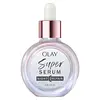What's inside
What's inside
 Key Ingredients
Key Ingredients

 Benefits
Benefits

 Concerns
Concerns

 Ingredients Side-by-side
Ingredients Side-by-side

Water
Skin ConditioningGlycerin
HumectantDimethicone
EmollientNiacinamide
SmoothingLactic Acid
BufferingPolyacrylate Crosspolymer-6
Emulsion StabilisingPalmitoyl Dipeptide-7
Skin ConditioningOryza Sativa Bran Extract
Skin Conditioning3-O-Ethyl Ascorbic Acid
Skin ConditioningSodium Hyaluronate
HumectantTocopheryl Acetate
AntioxidantPanthenol
Skin ConditioningTrehalose
HumectantSalicylic Acid
MaskingPEG-11 Methyl Ether Dimethicone
EmulsifyingSodium Lactate
BufferingSodium Benzoate
MaskingMica
Cosmetic ColorantTitanium Dioxide
Cosmetic ColorantWater, Glycerin, Dimethicone, Niacinamide, Lactic Acid, Polyacrylate Crosspolymer-6, Palmitoyl Dipeptide-7, Oryza Sativa Bran Extract, 3-O-Ethyl Ascorbic Acid, Sodium Hyaluronate, Tocopheryl Acetate, Panthenol, Trehalose, Salicylic Acid, PEG-11 Methyl Ether Dimethicone, Sodium Lactate, Sodium Benzoate, Mica, Titanium Dioxide
Water
Skin ConditioningCaprylic/Capric Triglyceride
MaskingC12-15 Alkyl Benzoate
AntimicrobialPropanediol
SolventShea Butter Ethyl Esters
EmollientDicaprylyl Carbonate
EmollientCetearyl Alcohol
EmollientDimethicone
EmollientSqualane
EmollientBehenyl Alcohol
EmollientHydrogenated Vegetable Glycerides
EmollientIsoamyl Laurate
EmollientAleurites Moluccanus Seed Oil
Skin ConditioningGlyceryl Stearate
EmollientPEG-100 Stearate
Hydrogenated Vegetable Oil
EmollientHydrogenated Soybean Oil
EmollientCeteareth-20
CleansingGlycerin
HumectantPhenoxyethanol
PreservativePolysilicone-11
Sodium Stearoyl Glutamate
CleansingHydrogenated Olive Oil
Skin ConditioningCitric Acid
BufferingDimethyl Mea
BufferingPetrolatum
EmollientHydrogenated Jojoba Oil
AbrasiveEthylhexylglycerin
Skin ConditioningRetinol
Skin ConditioningRetinyl Linoleate
Skin ConditioningXanthan Gum
EmulsifyingPolysorbate 20
EmulsifyingParfum
MaskingTetrasodium Glutamate Diacetate
Helianthus Annuus Seed Oil
EmollientGlycine Soja Lipids
Skin ConditioningMaltodextrin
AbsorbentPentylene Glycol
Skin ConditioningCetyl Palmitate
EmollientLaureth-23
CleansingDisodium Acetyl Glucosamine Phosphate
Skin ConditioningSodium Glucuronate
HumectantNephelium Lappaceum Leaf Extract
Skin ConditioningSodium Acetylated Hyaluronate
HumectantSodium Hyaluronate
HumectantCeramide NP
Skin ConditioningSodium Hydroxide
BufferingTrideceth-6 Phosphate
EmulsifyingMagnesium Aspartate
Skin ConditioningZinc Gluconate
Skin ConditioningRosmarinus Officinalis Leaf Extract
AntimicrobialMagnesium Sulfate
Sodium Hyaluronate Crosspolymer
HumectantHyaluronic Acid
HumectantPhytosterols
Skin ConditioningTocopherol
AntioxidantCopper Gluconate
Skin ConditioningCitronellol
PerfumingGeraniol
PerfumingHydroxycitronellal
PerfumingEugenol
PerfumingWater, Caprylic/Capric Triglyceride, C12-15 Alkyl Benzoate, Propanediol, Shea Butter Ethyl Esters, Dicaprylyl Carbonate, Cetearyl Alcohol, Dimethicone, Squalane, Behenyl Alcohol, Hydrogenated Vegetable Glycerides, Isoamyl Laurate, Aleurites Moluccanus Seed Oil, Glyceryl Stearate, PEG-100 Stearate, Hydrogenated Vegetable Oil, Hydrogenated Soybean Oil, Ceteareth-20, Glycerin, Phenoxyethanol, Polysilicone-11, Sodium Stearoyl Glutamate, Hydrogenated Olive Oil, Citric Acid, Dimethyl Mea, Petrolatum, Hydrogenated Jojoba Oil, Ethylhexylglycerin, Retinol, Retinyl Linoleate, Xanthan Gum, Polysorbate 20, Parfum, Tetrasodium Glutamate Diacetate, Helianthus Annuus Seed Oil, Glycine Soja Lipids, Maltodextrin, Pentylene Glycol, Cetyl Palmitate, Laureth-23, Disodium Acetyl Glucosamine Phosphate, Sodium Glucuronate, Nephelium Lappaceum Leaf Extract, Sodium Acetylated Hyaluronate, Sodium Hyaluronate, Ceramide NP, Sodium Hydroxide, Trideceth-6 Phosphate, Magnesium Aspartate, Zinc Gluconate, Rosmarinus Officinalis Leaf Extract, Magnesium Sulfate, Sodium Hyaluronate Crosspolymer, Hyaluronic Acid, Phytosterols, Tocopherol, Copper Gluconate, Citronellol, Geraniol, Hydroxycitronellal, Eugenol
Ingredients Explained
These ingredients are found in both products.
Ingredients higher up in an ingredient list are typically present in a larger amount.
Dimethicone is a type of synthetic silicone created from natural materials such as quartz.
What it does:
Dimethicone comes in different viscosities:
Depending on the viscosity, dimethicone has different properties.
Ingredients lists don't always show which type is used, so we recommend reaching out to the brand if you have questions about the viscosity.
This ingredient is unlikely to cause irritation because it does not get absorbed into skin. However, people with silicone allergies should be careful about using this ingredient.
Note: Dimethicone may contribute to pilling. This is because it is not oil or water soluble, so pilling may occur when layered with products. When mixed with heavy oils in a formula, the outcome is also quite greasy.
Learn more about DimethiconeGlycerin is already naturally found in your skin. It helps moisturize and protect your skin.
A study from 2016 found glycerin to be more effective as a humectant than AHAs and hyaluronic acid.
As a humectant, it helps the skin stay hydrated by pulling moisture to your skin. The low molecular weight of glycerin allows it to pull moisture into the deeper layers of your skin.
Hydrated skin improves your skin barrier; Your skin barrier helps protect against irritants and bacteria.
Glycerin has also been found to have antimicrobial and antiviral properties. Due to these properties, glycerin is often used in wound and burn treatments.
In cosmetics, glycerin is usually derived from plants such as soybean or palm. However, it can also be sourced from animals, such as tallow or animal fat.
This ingredient is organic, colorless, odorless, and non-toxic.
Glycerin is the name for this ingredient in American English. British English uses Glycerol/Glycerine.
Learn more about GlycerinSodium Hyaluronate is hyaluronic acid's salt form. It is commonly derived from the sodium salt of hyaluronic acid.
Like hyaluronic acid, it is great at holding water and acts as a humectant. This makes it a great skin hydrating ingredient.
Sodium Hyaluronate is naturally occurring in our bodies and is mostly found in eye fluid and joints.
These are some other common types of Hyaluronic Acid:
Learn more about Sodium HyaluronateWater. It's the most common cosmetic ingredient of all. You'll usually see it at the top of ingredient lists, meaning that it makes up the largest part of the product.
So why is it so popular? Water most often acts as a solvent - this means that it helps dissolve other ingredients into the formulation.
You'll also recognize water as that liquid we all need to stay alive. If you see this, drink a glass of water. Stay hydrated!
Learn more about Water